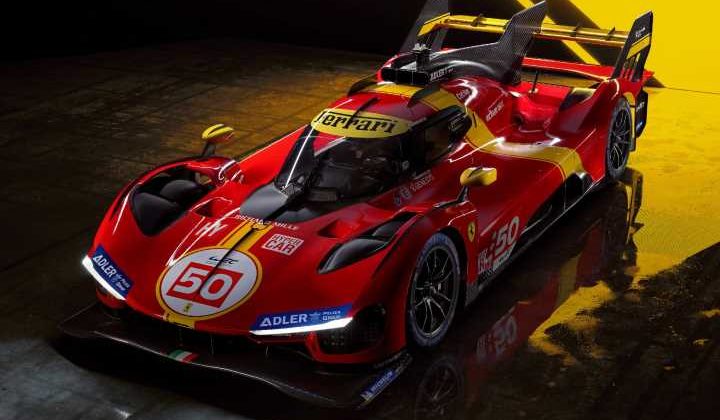Maranello dreams big as it seeks to dominate a new era of top-tier endurance racing with V6-powered 499P
By Cam Tait / Saturday, 29 October 2022 / Loading comments
This is it. The first factory-backed Ferrari prototype to take on the gruelling 24 Hours of Le Mans in half a century, where it’ll fight for outright honours in what is set to be one of the most competitive grids in the World Endurance Championship in decades. It’s called the 499P and it might just be Ferrari’s first Le Mans winner since the 250LM in 1965.
A quick refresher on the top-tier endurance regs for next year, because they’re a tad complex. Ferrari will be joining Toyota, Peugeot and Glickenhaus in the LMH category. Once planned as a road car-based formula, LMH has now morphed into the flagship prototype category, where manufacturers are free to design their own chassis, engines and hybrid systems. LMDh, meanwhile, is a bit more restrictive. Manufacturers must base their cars on an LMP2-style chassis supplied by one of four independent constructors and use a stock hybrid system. It’s a cheaper solution, though, and has attracted Porsche, Lamborghini, BMW, Cadillac and Alpine.
Back to the 499P. It’s powered by a bespoke 3.0-litre, 120-degree hot vee-style twin-turbo V6, which alone produces 680hp – the maximum allowed under the LMH regs – sent exclusively to the rear wheels. Sound familiar? It’s the same engine architecture as the 296 GTB, though Ferrari says the block is the only carryover from the road car. All the internals are bespoke to the Le Mans racer, and unlike Ferrari’s GT racers the 499P’s engine is load-bearing, so it plays a doubly important role.
There’s clearly a lot of road relevance in a V6, but was a V12 ever on the cards? “In the very initial phase, we considered a V12, V8, V6. Everything, to be honest, because I do believe that before making any decision we need to understand what we are missing if you select in one direction. Selecting the V6 was not a compromise, but was definitely the right path to follow considering the way our range of road cars is moving, so it was natural to go there”, said Ferrari GT chief Ferdinando Cannizzo. “And also the fact that the V6 is small, light, very compact. This gave it the advantage of packaging, the weight of the car, centre of gravity, weight distribution and so on.”
At least a V12 was considered, then, even if it was taken off the table early on. Of course, the lighter V6 allows Ferrari to fit an incredibly complex hybrid system, which centres on a 272hp electric motor. Power is sent solely to the front wheels and is used to take some of the workload off the combustion engine above 75mph – again, that’s mandatory to prevent cars from rocketing out of bends. There’s a differential up front that tops up the F1-inspired 900-volt battery under braking, meaning the yet-to-be-announced drivers will have to get their heads around a brake-by-wire system. Thankfully, they’ve already done 7,500 miles of development work to get the hang of it and work out what all the buttons do on the space-age steering wheel.
Though it doesn’t look as whacky as the wingless Peugeot 9X8, there’s some radical aerodynamic work at play on the 499P. The rear, for instance, is split into three vertical sections – with a massive central tail fin that dwarfs anything else on the grid – and three horizonal sections, below which sits a gigantic diffuser. Predictably, Ferrari isn’t revealing specific aero numbers, but both LMH and LMDh have a set downforce-to-drag ratio of 4:1 to help level the playing field. On paper, at least.
This also permits manufacturers to add their signature look to the car, something severely lacking during the LMP1 era. On the 499P, Ferrari has transferred over the horizontal daytime running lights from the Roma, Daytona SP3 and, er, the Purosangue. But below the surface is an intricate labyrinth of aerodynamic tunnels. A peek through the exposed cut-outs in the wheel arches not only reveals the double wishbone pushrod suspension layout, but also the vast ducts that run either side of the cockpit. Whatever isn’t sucked into the radiators is spat out the back, reducing drag and rocketing the car up to the ridiculous speeds Le Mans’ racers are known for.
If you’re an F1 fan, you’ll know that Ferrari is always looking for a cause for celebration so it can slap on a special livery. For the 499P, it’s chosen to race under the number 50, marking half a century since its final factory-backed prototype Le Mans effort, and 51, which it claims is the most successful number in its history. Well, that and the number one. No word on whether the yellow has any kind of significance, but it seems mega when paired with the orangey-red hue of Rosso Scuderia.
It looks the part, for sure, but we won’t find out if it’s a true contender until the 1,000 Miles of Sebring on March 17th. Ferrari will kick things off with two cars, run in collaboration with legendary GT outfit AF Corsa, but this new Hypercar era lends itself well to customer cars. While we won’t see any privateer-run 499Ps next year, Ferrari isn’t ruling out building a few more for its wealthy clientele. We’ll have to wait and see how competitive the car is, but one thing seems certain: we’re likely on the brink of a Le Mans golden era.
- Le Mans 2022 | PH Review
- Porsche unveils new 963 LMDh car for 2023
Latest General articles
Ferrari targets Le Mans win with all-new prototype
Toyota GR Supra manual vs Porsche Cayman GTS 4.0
Audi A8 LWB W12 | The Brave Pill
Cheap supercars | Six of the Best
EU agrees 2035 deadline for combustion engine ban
Source: Read Full Article
